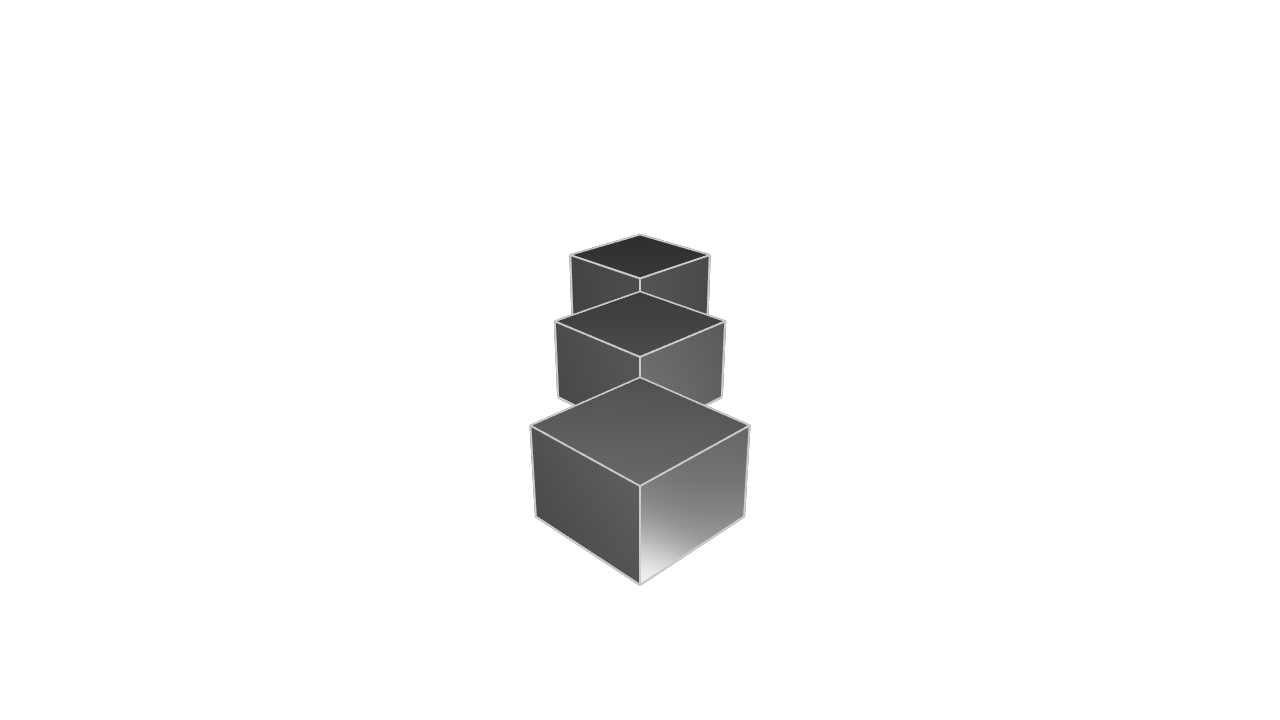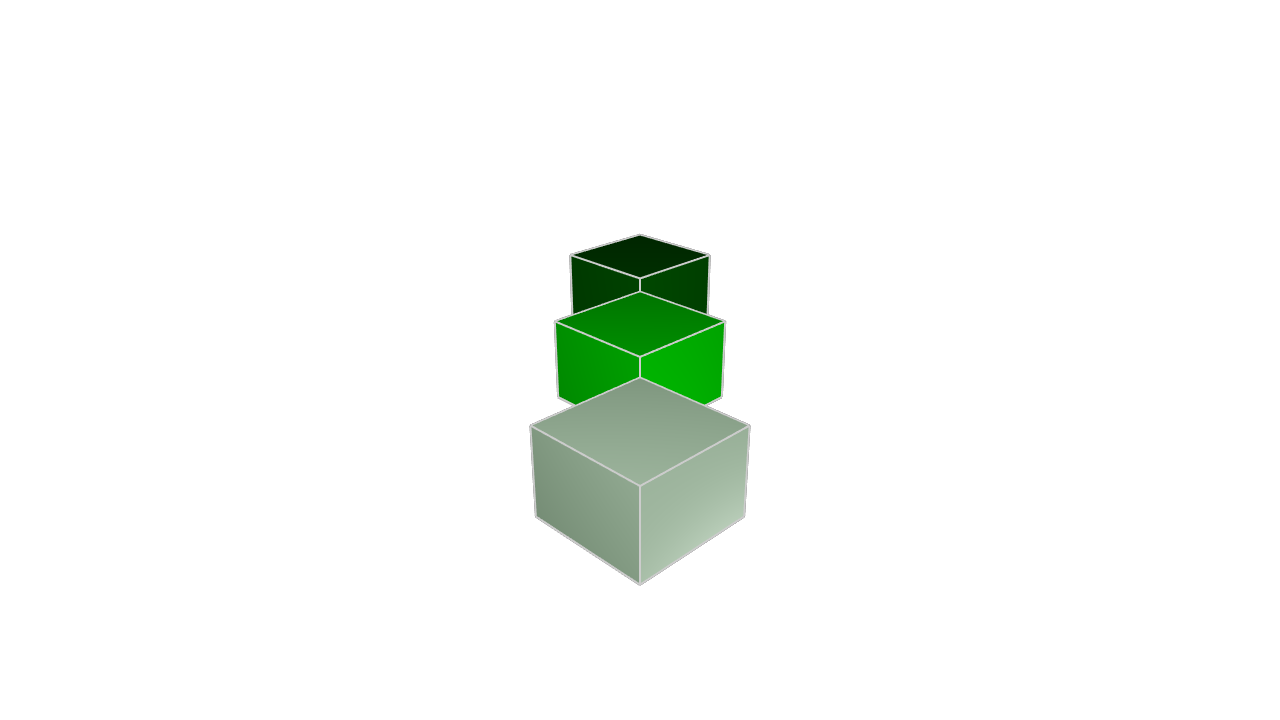Iterating with map and reduce
Every programming language has a way to do iteration: to repeat the same task many times. Traditional programming languages like Python, JavaScript or C use loops. KCL doesn't have any loops, but we have something very similar: arrays, and two helper functions called map and reduce. Let's see how they can solve problems.
Transforming arrays with map
The map function lets you transform an array by calling a function on every element. For example:
inputArray = [1, 2, 3, 4]
fn squareNumber(@x) { return x * x }
outputArray = map(inputArray, f = squareNumber)
The map function takes an input array as its first argument, then a function (its label is abbreviated to just f). It calls the function on every element of the input array, and returns it. If you open the Variables pane, you'll see that outputArray is [1, 4, 9, 16], just as we expected.
You can use map to create geometry too! For example, let's make 3 cubes, next to each other.
fn cube(@offset) {
return startSketchOn(XY)
|> startProfile(at = [0, 0])
|> polygon(radius = 10, numSides = 4, center = [0, offset])
|> extrude(length = 10)
}
offsets = [0, 25, 50]
cubes = map(offsets, f = cube)

We created an array of offsets, then called the cube function on each offset in the array. The final result is an array of cubes. Calling the cube function drew the three cubes, each at their own offset.
So far so good. But this is basically just a 3D pattern. We can make this more interesting by making each cube a different color. Instead of an array of offsets, we'll store an array of offsets and colors. To do this, we'll make a KCL object. An object has multiple properties, each with its own label and value. For example:
myObject = {
offset = 25,
color = "#00ff00",
}
This object has two fields, offset and color. You could access them by calling myObject.offset and myObject.color. Let's see how we can use this with map:
fn cube(@params) {
offset = params.x
color = params.color
return startSketchOn(XY)
|> startProfile(at = [0, 0])
|> polygon(radius = 10, numSides = 4, center = [0, offset])
|> extrude(length = 10)
|> appearance(color = color)
}
offsets = [
{ x = 0, color = "#99ff99" }, // Dark green
{ x = 25, color = "#00ff00" }, // Bright green
{ x = 50, color = "#002200" }, // Pale green
]
map(offsets, f = cube)

Remember, map takes in an array, and outputs an array. The arrays always have the same length. Item x in the input array will be f(x) in the output array, where f is whichever function you pass in.
Anonymous functions
It can get annoying defining a new function every time you want to use map. For instance, in the earlier example where we defined a fn squareNumber to use in a map -- is that really necessary? If you have a lot of map calls, you'll slowly find your code becoming littered with tiny functions that you only use in a map.
KCL supports a nice little feature that can simplify this: anonymous functions. They're functions that don't have a name. You declare them where you need them, they're passed into mapand they aren't available after. Let's have a look:
inputArray = [1, 2, 3, 4]
outputArray = map(inputArray, f = fn (@x) { return x * x })
In this variation, we're passing in an anonymous function as the argument f of map. Just like before, it takes a single input argument x, squares it, and returns it. It should produce the exact same output as the earlier example with a function named squareNumber.
You can choose to use either named or anonymous functions with map. Neither is better or worse, you can use whichever you prefer. Generally, if a function is only a single line long, and you're only going to call it once (in a map or something similar), then you should consider making it anonymous and passing it as an argument directly.
Consuming arrays with reduce
The map function lets you iterate over an array, producing another array with the same length. But what if you don't want to get an array out? For example, what if you want to sum an array, or find the average?
The answer is: use the reduce function. This function, like map, takes an array and a function, then it calls the function on every element in the array. The difference is:
- In
map, the function argumentftakes a single arg: the array's item being processed, often calledi. - In
reduce, the function argumentftakes two args: the array's item being processedias well as a second value that accumulates across the array. It's calledaccum, short for reduce.
Let's see an example:
inputArray = [1, 2, 3, 4]
sum = reduce(inputArray, initial = 0, f = fn(@i, accum) { return i + accum })
If you open sum in the Variables pane, you'll see it's 10, as we expect. How does this work? Let's break it down and see what happens in each step of the reduce.
- The
reducestarts. It setsaccumto its initial value, which is theinitial = 0arg. So,accumstarts at 0. - Reduce starts iterating over the array.
- The first item is
1. Reduce callsf, passingi=1andaccum=0. Thenfreturns1+0, or 1. This becomes the new value ofaccum. - The next item is
2. Reduce callsf, passingi=2andaccum=1. Thenfreturns2+1, or 3. This becomes the new value ofaccum. - The next item is
3. Reduce callsf, passingi=3andaccum=3. Thenfreturns3+3, or 6. This becomes the new value ofaccum. - The next item is
4. Reduce callsf, passingi=4andaccum=6. Thenfreturns4+6, or 10. This becomes the new value ofaccum. - There's no more array items to handle, so reduce returns the last accumulated value, 10.
That's how reduce can take a long list of items and reduce it to a single item, accumulating the answer as it goes through the array.
What are some other things we can do with reduce? We could calculate the product of an array:
reduce(inputArray, initial = 1, f = fn(@i, accum) { return i * accum})
In the next chapter we'll cover one of the most powerful uses for reduce: dynamically building up geometry.